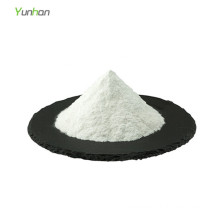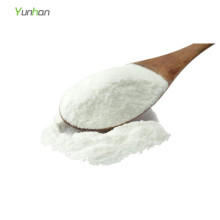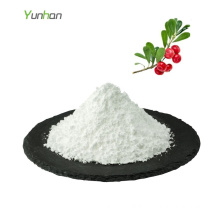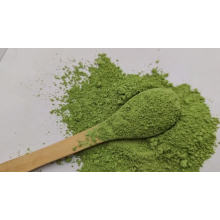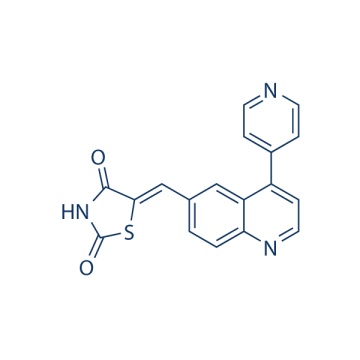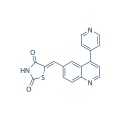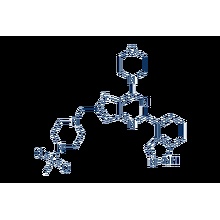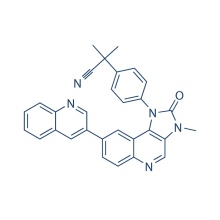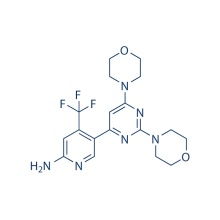GSK1059615 958852-01-2
Product Description
.cp_wz table {border-top: 1px solid #ccc;border-left:1px solid #ccc; } .cp_wz table td{border-right: 1px solid #ccc; border-bottom: 1px solid #ccc; padding: 5px 0px 0px 5px;} .cp_wz table th {border-right: 1px solid #ccc;border-bottom: 1px solid #ccc; padding: 5px 0px 0px 5px;}
Molecular Weight: 333.36 GSK1059615 is a dual inhibitor of PI3Kα/β/δ/γ (reversible) and mTOR with IC50 of 0.4 nM/0.6 nM/2 nM/5 nM and 12 nM, respectively. Phase 1.
The pyridinylquinoline derivative GSK1059615 is a novel,
ATP-competitive, and reversible inhibitor of the class I family of
PI3Ks. GSK1059615 inhibits PI3K signaling, induces G1 arrest and
Apoptosis, especially in breast tumor cells. Data summarized in another review also shows that GSK1059615 inhibits PI3Kα, β, γ and δ, with Ki of 0.42 nM, 0.6 nM, 0.47 nM and 1.7 nM, respectively. Another report shows that GSK1059615 inhibits PI3Kα with IC50 of 2 nM.
In T47D and BT474 cancer cells, GSK1059615 inhibits the phosphorylation
of Akt at S473, with IC50 of 40 nM.
In xenograft mice models of BT474 or HCC1954 breast cancer cells, GSK1059615 (25 mg/kg) effectively inhibits tumor growth.
A novel, ATP-competitive, and reversible inhibitor of both PI3Kα, β, δ, and γ, and mTOR.
Protocol(Only for Reference)
Kinase Assay: [4]
Cell Assay: [4]
Animal Study: [3]
Conversion of different model animals based on BSA (Value based on data from FDA Draft Guidelines)
For example, to modify the dose of resveratrol used for a mouse (22.4 mg/kg) to a dose based on the BSA for a rat, multiply 22.4 mg/kg by the Km factor for a mouse and then divide by the Km factor for a rat. This calculation results in a rat equivalent dose for resveratrol of 11.2 mg/kg.
Chemical Information
Molarity Calculator
Dilution Calculator
Molecular Weight Calculator
Contact us if you need more details on GSK1059615 958852-01-2. We are ready to answer your questions on packaging, logistics, certification or any other aspects about 958852-01-2 GSK1059615、958852-01-2. If these products fail to match your need, please contact us and we would like to provide relevant information.
Molecular Weight: 333.36 GSK1059615 is a dual inhibitor of PI3Kα/β/δ/γ (reversible) and mTOR with IC50 of 0.4 nM/0.6 nM/2 nM/5 nM and 12 nM, respectively. Phase 1.
The pyridinylquinoline derivative GSK1059615 is a novel,
ATP-competitive, and reversible inhibitor of the class I family of
PI3Ks. GSK1059615 inhibits PI3K signaling, induces G1 arrest and
Apoptosis, especially in breast tumor cells. Data summarized in another review also shows that GSK1059615 inhibits PI3Kα, β, γ and δ, with Ki of 0.42 nM, 0.6 nM, 0.47 nM and 1.7 nM, respectively. Another report shows that GSK1059615 inhibits PI3Kα with IC50 of 2 nM.
In T47D and BT474 cancer cells, GSK1059615 inhibits the phosphorylation
of Akt at S473, with IC50 of 40 nM.
In xenograft mice models of BT474 or HCC1954 breast cancer cells, GSK1059615 (25 mg/kg) effectively inhibits tumor growth.
A novel, ATP-competitive, and reversible inhibitor of both PI3Kα, β, δ, and γ, and mTOR.
Protocol(Only for Reference)
Kinase Assay: [4]
| HTRF In vitro Profiling Assays for PI3K Inhibition | The measurement of the GSK1059615-dependent inhibition of the PI3Ks is accessed using a HTRF based PI3K profiling assay kit. 400 pM enzyme is used in PI3Kα and δ assays, 200 pM in PI3Kβ assays, and 1 nM in PI3Kγ assay. In addition, the PI3Kα, β, and δ assays are run with 150 mM NaCl and 100 μM ATP, while the PI3Kγ assay is run with no NaCl and 15 μM ATP. All reactions are run at 10 μM PIP2. GSK1059615 is serially diluted (3-fold in DMSO), and 50 nL is transferred to a 384-well low-volume assay plate. PI3K Reaction Buffer is prepared by diluting the stock 1:4 with de-ionized water. Freshly prepared DTT is added at a final concentration of 5 mM on the day of use. Enzyme addition and GSK1059615 pre-incubation are initiated by the addition of 2.5 µL of PI3K in reaction buffer. Plates are incubated at room temperature for 15 min. Reactions are initiated by addition of 2.5 µL of 2× substrate solution (PIP2 and ATP in 1× reaction buffer). Plates are incubated at room temperature for one hour. Reactions are quenched by the addition of 2.5 µL of stop solution. The quenched reactions are then processed to detect product formation by adding 2.5 µL of Detection Solution. Following a 1-hour incubation in the dark, the HTRF signal is measured on the Envision plate reader set for 330nm excitation and dual emission detection at 620nm (Eu) and 665nm (APC). The IC50 value is then obtained. |
|---|
Cell Assay: [4]
| Cell lines | T47D and BT474 cells |
|---|---|
| Concentrations | 0–1 μM, serially diluted (3-fold) in DMSO |
| Incubation Time | 30 min |
| Method | Cells are plate at a density of 1 × 104 cells per well in clear flat-bottomed 96-well plates and incubated overnight. Then, GSK1059615 is added and the plates are incubated for 30 min. At the end of incubation, media is aspirated from the plates, and the plate is wash once with cold PBS. 80 μL MSD Lysis buffer is added into each well and the plates are incubated on a shaker at 4 °C for at least 30 min. For Akt duplex assay, plates are washed with 200 μL/well wash buffer for 4 times and tapped on paper towel to blot. Then, 60 μL lysates is added to each well and the plates are incubated on shaker at room temperature for 1 hour. After another 4 times washing, antibody is added (25 μL per well) and the plates are incubated on shaker for 1 hour and washed again. Finally, Read Buffer is added (150 μL per well) and the plates are read immediately. IC50 values are then obtained. |
Animal Study: [3]
| Animal Models | Xenograft mice models of BT474 or HCC1954 cells |
|---|---|
| Formulation | |
| Dosages | 25 mg/kg |
| Administration | Oral gavage |
Conversion of different model animals based on BSA (Value based on data from FDA Draft Guidelines)
| Species | Baboon | Dog | Monkey | Rabbit | Guinea pig | Rat | Hamster | Mouse |
| Weight (kg) | 12 | 10 | 3 | 1.8 | 0.4 | 0.15 | 0.08 | 0.02 |
| Body Surface Area (m2) | 0.6 | 0.5 | 0.24 | 0.15 | 0.05 | 0.025 | 0.02 | 0.007 |
| Km factor | 20 | 20 | 12 | 12 | 8 | 6 | 5 | 3 |
| Animal A (mg/kg) = Animal B (mg/kg) multiplied by | Animal B Km |
| Animal A Km |
For example, to modify the dose of resveratrol used for a mouse (22.4 mg/kg) to a dose based on the BSA for a rat, multiply 22.4 mg/kg by the Km factor for a mouse and then divide by the Km factor for a rat. This calculation results in a rat equivalent dose for resveratrol of 11.2 mg/kg.
| Rat dose (mg/kg) = mouse dose (22.4 mg/kg) × | mouse Km(3) | = 11.2 mg/kg |
| rat Km(6) |
Chemical Information
| Molecular Weight (MW) | 333.36 |
|---|---|
| Formula | C18H11N3O2S |
| CAS No. | 958852-01-2 |
| Storage | 3 years -20℃Powder |
|---|---|
| 6 months-80℃in solvent (DMSO, water, etc.) | |
| Synonyms | |
| Solubility (25°C) * | In vitro | DMSO | 2 mg/mL (5.99 mM) |
|---|---|---|---|
| Water | <1 mg/mL ( | ||
| Ethanol | <1 mg/mL ( | ||
| * <1 mg/ml means slightly soluble or insoluble. * Please note that Selleck tests the solubility of all compounds in-house, and the actual solubility may differ slightly from published values. This is normal and is due to slight batch-to-batch variations. | |||
| Chemical Name | (Z)-5-((4-(pyridin-4-yl)quinolin-6-yl)methylene)thiazolidine-2,4-dione |
|---|
Molarity Calculator
Dilution Calculator
Molecular Weight Calculator
Contact us if you need more details on GSK1059615 958852-01-2. We are ready to answer your questions on packaging, logistics, certification or any other aspects about 958852-01-2 GSK1059615、958852-01-2. If these products fail to match your need, please contact us and we would like to provide relevant information.
Product Categories : PI3K/Akt/mTOR > PI3K Inhibitor
Other Products
Hot Products
Astragaloside AChlortetracycline HCl 64-72-2Paclitaxel 33069-62-4Dexamethasone Acetate 1177-87-3Dinaciclib (SCH727965) 779353-01-4CHIR-124 405168-58-3Ro3280 1062243-51-9TAME 901-47-3CCG-1423 285986-88-110058-F4 403811-55-2Dabigatran (BIBR 953) 211914-51-1H 89 2HCl 130964-39-5T0901317 293754-55-9Aprepitant 170729-80-3Turofexorate Isopropyl (XL335) 629664-81-9BMS-378806 357263-13-9

